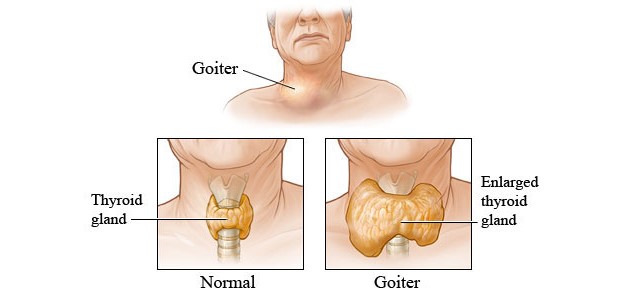Goiter, also known as thyroid enlargement, is an abnormal enlargement of the thyroid gland caused by various factors. To effectively treat this condition, it is essential to determine the precise size, symptoms, and associated causes. Let’s delve into the world of goiter through the following article by Thu Cúc TCI.

Images of the normal thyroid gland and enlarged thyroid gland
1. Thyroid Structure
The thyroid is an endocrine organ shaped like a butterfly located in the front of the neck, responsible for producing thyroid hormones. This gland comprises two lobes connected by a thin tissue known as the isthmus. The structure of the thyroid includes:
– Lobes: The thyroid gland consists of two lobes, large oval-shaped structures on either side of the trachea. The lobes are symmetrical and wrap around the trachea.
– Isthmus: The isthmus is a small bridge of tissue that connects the two lobes of the thyroid gland. It is situated in front of the trachea, just below Adam’s apple.
– Follicles: The thyroid gland consists of numerous spherical structures called follicles. Each follicle is composed of a layer of thyroid cells surrounding a central space filled with a substance known as colloid.
– Thyroid Cells: The cells in the thyroid follicles are the primary functional cells of the thyroid gland. They produce, store, and release two types of hormones: thyroxine (T4) and triiodothyronine (T3), which regulate the body’s metabolic processes.
– Colloid: Colloid is a gel-like substance filling the central space of each follicle. It contains the precursor of thyroid hormones and serves as a storage site for these hormones.
– Blood Vessels: The thyroid gland is richly supplied with blood vessels, including arteries and veins, ensuring a plentiful blood supply. These blood vessels deliver oxygen and nutrients to the thyroid gland while removing waste products.
2. Thyroid Volume
The volume of the thyroid gland can vary significantly among individuals due to various factors.
– Adult males: 25 mL
– Adult females: 18 mL
– Adolescents (13-14 years old): 8-10 mL
– Children (3-4 years old): 3 mL
– Infants: 0.8-1.5 mL
3. Symptoms of Goiter
The size of the thyroid gland can vary, and it may or may not cause symptoms. When symptoms are present, they may include:
– Visible swelling or lump in the neck: Goiter can result in swelling at the front of the neck, often resembling a lump or protrusion.

Swelling in the neck due to an enlarged thyroid gland
– Difficulty swallowing or breathing: In some cases, a large goiter can exert pressure on the esophagus or trachea, leading to difficulty swallowing or breathing. This can cause a sensation of tightness or throat constriction.
– Hoarseness or changes in voice: If the enlarged thyroid compresses the nerves related to the vocal cords, it may lead to hoarseness or changes in voice.
– Discomfort or pain in the neck: Some individuals may experience mild discomfort or pain in the neck region.
– Symptoms of thyroid dysfunction: Depending on the underlying cause of the condition, symptoms of overactive (hyperthyroidism) or underactive (hypothyroidism) thyroid function may manifest. These symptoms can include weight changes, fatigue, mood swings, intolerance to heat or cold, hair loss, changes in heart rate, and more.
4. Causes of Goiter
4.1. Iodine deficiency goiter
The thyroid gland requires an adequate amount of iodine to produce thyroid hormones. When the body lacks iodine, it can lead to goiter as the gland attempts to compensate for the deficiency.
4.2. Hashimoto’s thyroiditis
This is an autoimmune condition where the body’s immune system mistakenly attacks the thyroid gland. Over time, the inflammation caused by the immune response can lead to goiter.
4.3. Graves’ disease
Another autoimmune disorder, Graves’ disease, stimulates the immune system to produce excessive thyroid hormones. Overactivity of this immune system can result in goiter.
4.4. Multinodular goiter
This refers to the presence of multiple nodules within the thyroid, causing its expansion. The exact cause of multinodular goiter is often unknown, but it may be related to iodine deficiency or genetic factors.
4.5. Solitary thyroid nodule
This is a single lump or nodule within the thyroid gland. While most of these nodules are benign, in some cases, they may indicate thyroid cancer.
4.6. Thyroid cancer
Thyroid cancer is another cause of goiter. Malignant tumors within the thyroid gland can increase its size.
4.7. Goitrogens
Goitrogens are substances that inhibit thyroid function and may contribute to goiter. Some foods containing goitrogens include cabbage, Brussels sprouts, soy products, nuts, and certain medications.
4.8. Deposition diseases like Amyloidosis
This rare condition causes proteins to clump together into amyloid clusters, leading to accumulations in tissues and organs, including the thyroid gland. Amyloid deposition can cause goiter.
4.9. Plummer-Vinson syndrome
This rare condition is characterized by the combination of thyroid enlargement and iron deficiency. It is a mucosal membrane disorder typically seen in middle-aged women.
4.10. Pregnancy
During pregnancy, hormonal and growth factor changes can increase the thyroid gland’s size, resulting in goiter.
It is crucial to accurately determine the cause of goiter through examination and evaluation by a specialized physician.

Hormonal changes during pregnancy can increase the volume of the thyroid gland, leading to an enlarged thyroid gland.
5. Prevention of Goiter
Preventive measures for enlarged thyroid include:
– Maintaining a balanced diet.
– Iodine supplementation.
– Avoiding goitrogens.
– Regular thyroid check-ups.
– Minimizing exposure to toxic substances.
– Stress management.








